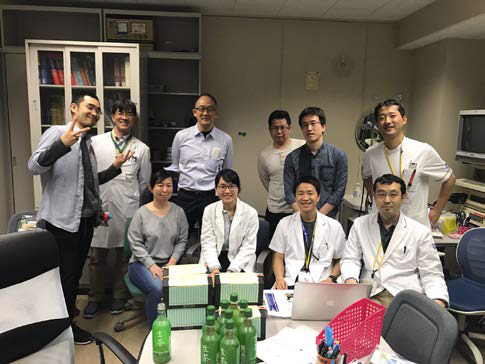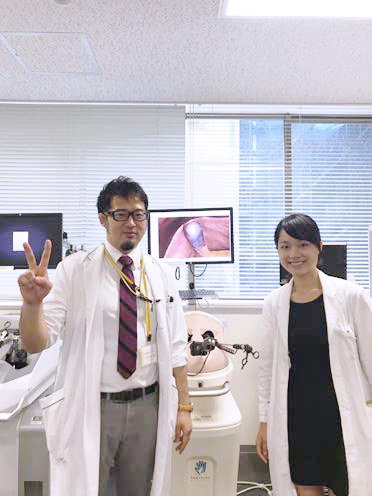Clinical Exchange in Japan
Welcome to Japan and Nagoya University school of Medicine!
Experience Report
Name: Chan Tsz Ying
School: The Chinese University of Hong Kong
Study Period: 10 April – 12 May 2017
Departments: Pediatrics Surgery & Gastrointestinal Surgery
Since the health care system in Japan and Hong Kong differ greatly, one of my objectives of the elective is to appreciate the difference and learn the strength of the different system in Japan.
Japan has been well known for her advance knowledge and technique in performing gastroenterological surgery. Therefore, I had chosen gastrointestinal surgery as one of the department for attachment in order to compare if there is any difference in the surgery techniques when comparing to those I observed in Hong Kong.
Pediatrics surgery is another department that I attached during the elective as I have been interested in pediatrics surgery and yet did not have the chance to follow any pediatrics surgery deparment in Hong Kong.
During the elective, I had participated in various clinical activities. In both departments, I had followed the morning ward rounds. By doing so, I can have a look at the setting of hospital in Japan which is actually a bit different from Hong Kong.
Normally, there will be 4 patients in a room and they are curtained off. When comparing to most of the public hospitals in Hong Kong (maybe due to the overcrowding), this setting is more comfortable and patient privacy can be better protected. I can also learn the managements of different cases during the ward rounds.
For example, when to change the wound dressing, how to monitor a patient post-operatively,etc.
Besides, I have observed quite a number of surgeries during this 1-month elective and sometimes I can even scrub in to assist the surgery. For gastrointestinal surgery, it enables me to appreciate the different approach adopted by Japanese surgeons. The first operation I observed in gastrointestinal surgery department was for distal cholangiocarcinoma. I was impressed by a detailed and colored illustration of the anatomy related to the surgery and was very surprised to know that the surgeon drew it according to the imaging results. It is because the anatomical structures often varies from patient to patient and they believe by doing so, a better operative outcome can be achieved. Apart from the illustrations prepared before operation, their diligence can be shown during the operation when they are dissecting the arteries, veins and the organs, they will use threads of different colors for clearer indications of different structures.
For Pediatrics surgery, since it was my very first time to observe an operation done on newborns, I was really impressed by the size difference between an adult and a newborn on the operating table. I once again realized how vulnerable a newborn could be when I was told that the temperature in Operation Theater for pediatrics surgery is especially high to prevent hypothermia in the babies. The room temperature may be up to 30 degree celsius if the patient is a preterm baby. I was given a chance to scrub in to assist a case of congenital diaphragmatic hernia repair. Although I just did the minor things during the operations, still I was excited and grateful to join in this major surgery. I was also given the opportunity to take part in the endoscopic balloon dilation for esophageal stenosis in a 3 year-old child. All these helped polishing up my skills.
Apart from taking part in the real operations, I was also given the suturing tutorials, laparoscopic simulation and ultrasound trainings. The teachings are all very clear even with some language barriers. It helped improving my suturing techniques and gave me a taste of laparoscopic surgery. The doctors here are all very encouraging which make the learning even more enjoyable. My supervisor in gastrointestinal surgery department even gave me training on ultrasound when he knew I did not have a chance to operate ultrasound machine in Hong Kong.
I also attended the student presentations in both departments. The students here were allocated to take care of different patients throughout their attachment to these two departments. I think this practice is quite good as the medical students can have a taste of following a patient as a doctor in charge and they can have a better understanding on the case as well as establish a closer relationship with the patients.
Although most of their presentations were done in Japanese, I can understand most of it by reading the Chinese Characters on the PowerPoint together with the supplementary English explanations by other students.
Moreover, I participated in numerous meetings and seminars of both departments.
During the meetings of pediatrics surgery, every single case in the ward would be discussed. It was very kind of the doctors and students to present the cases in English just because of me. By
attending the meetings, I can better understand the progress of different cases in the ward. They also have a seminar for academic paper review every week. By doing so, we can appreciate and learn the up to date information of the field.
Sometimes there were also conferences about researches or publications of the clinical journal paper. Although most of the contents were too difficult for me as an undergraduate, it broadened my horizon and allowed me to know more about the direction of various clinical researches going on in the field.
Last but not least, I grabbed the golden opportunities to communicate with the doctors and local students whenever it was possible. By doing so, I can have a better understanding on the medical system in Japan. For instance, sometimes surgeons are responsible for delivering chemotherapy or radiotherapy to their patients since Japanese prefer to be taken care by the same doctor all along the way. Apart from medical systems, I also learnt the difference between our curriculums and theirs.
There are more self-learning components in their school. There is not any lecture in their clinical years and they need to learn as much as they can during the clerkship and also supplemented by some self-reading. In their final years, they can choose three departments and take the role as pre-intern there. Meanwhile, they need to revise for the school exams and national doctor test. I personally quite appreciate the arrangement of their final year as it can give the students more chance to participate in the routine works of a doctor and also allow them to explore their interests in different specialty.
In conclusion, my 5-week elective in Nagoya University Graduate School of Medicine was definitely a great and memorable one. It provided me with greater exposure to various clinical settings. I was able to acquire both medical knowledge and hands-on experience during the clinical clerkship.


(from left to right:) With doctors in Pediatrics surgery
With my supervisor in Gastrointestinal Surgery during laparoscopic surgery simulator training
Click here to read other stories
Nagoya University Graduate School of Medicine